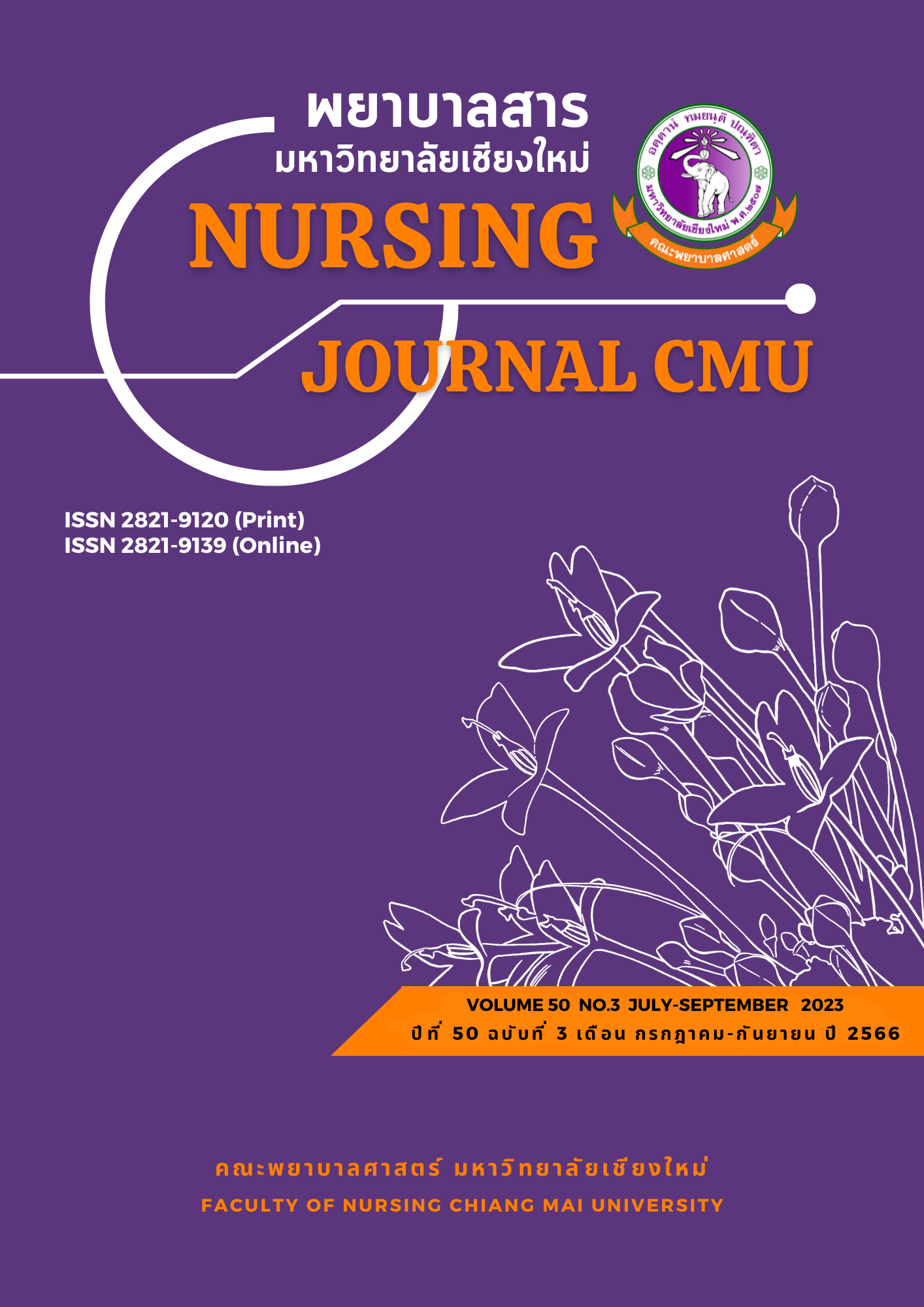The Relationships Between Health Beliefs and Infection Prevention Behaviors Among Patients with Lung Cancer Receiving Chemotherapy
Keywords:
Lung cancer, Health beliefs, Infection prevention behavior, ChemotherapyAbstract
Infection in patients with cancer receiving chemotherapy results in a high chance of death. Appropriate behaviors can prevent infection. This descriptive correlational research aimed to examine the relationships between health beliefs and infection prevention behaviors among patients receiving chemotherapy. Using a random number table, 72 patients receiving chemotherapy at the Cancer Clinic in Roi-Et Hospital were selected. The research instruments were the Health Beliefs and Infection Prevention Behaviors questionnaires, which had reliability of .82 and .84, respectively. The data were analyzed using descriptive statistics and Pearson’s product-moment correlation.
The results showed that health beliefs in the dimensions of perceived susceptibility to infection and perceived benefits of action had a statistically significant positive correlation with infection prevention behaviors (r = .34 and .38, p < .05). Perceived barriers to action had a statistically significant negative correlation with infection prevention behaviors (r = -.19, p < .05), and perceived severity of infection did not correlate significantly with infection prevention behaviors.
The results of the study indicated that health beliefs in the dimensions of perceived susceptibility to infection, perceived benefits of action, and perceived barriers to action correlated with infection prevention behaviors. Therefore, healthcare providers should create strategies to promote these perceptions with emphasis on perceived severity of infection, and encourage appropriate behaviors to prevent infection.
References
Almohammadi, A., Alqarni, A., Alraddadi, R., & Alzahrani, F. (2020). Assessment of patients’ knowledge in managing side effects of chemotherapy: Case of King Abdul-Aziz University Hospital. Journal of Cancer Education, 35, 334-338. https://doi.org/10.1016/j.ejon.2018.06.005
American Cancer Society. (2020). Cancer facts & figures 2020. https://www.cancer.org/ research/cancer-facts-statistics/all-cancer-facts-figures/cancer-facts-figures-2020.html
Boccia, R., Glaspy, J., Crawford, J., & Aapro, M. (2022). Chemotherapy-induced neutropenia and febrile neutropenia in the US: A beast of burden that needs to be tamed? The Oncologist, 27(8), 625-636. https://doi.org/10.1093/oncolo/oyac074
Cohen, J. (1988). Statistical power analysis for the behavioral sciences (2nd ed.). Routledge.
Cortés, Á. A., Urquizu, L. C., & Cubero, J. H. (2015). Adjuvant chemotherapy in non- small cell lung cancer: State-of-the-art. Translational Lung Cancer Research, 4(2), 191-197. https://doi.org/10.3978/j.issn.2218-6751.2014.06.01
Esfandbod, M., Tehrani, M. A., Haghshomar, M., Arya, P., Amiri, B. S., Toogeh, G., & Keyhani, M. (2022). Association between perceived stress and neutropenia in patients with leukemia under chemotherapy. International Journal of Hematology-Oncology and Stem Cell Research, 16(2), 103-109.
Han, A., & Choi, J. S. (2018). Factors influencing infection prevention self-care behaviors in patients with hematologic cancer after discharge. European Journal of Oncology Nursing, 35, 102-106. https://doi.org/10.1016/j.ejon.2018.06.005
Maneewong, J., & Panthu, K. (2022). The relationship among knowledge, health beliefs and practices in prevention of hospital-associated infections among nursing students. HCU Journal of Health Science, 26(1), 1-24. (in Thai)
McGregor, B. A., Antoni, M. H., Boyers, A., Alferi, S. M., Blomberg, B. B., & Carver, C. S. (2004). Cognitive–behavioral stress management increases benefit finding and immune function among women with early-stage breast cancer. Journal of Psychosomatic Research, 56(1), 1-8.
National Cancer Institute. (2017). Cancer treatment. https://www.cancer.gov/ about- cancer/treatment (in Thai)
Polit, D. F., & Beck, C. T. (2019). Nursing research: Generating and assign evidence for nursing practice (8th ed.). Lippincott.
Prasertsri, T., & Phanthusart, N. (2018). Influence factors and severity of infections within the cancer patient. Journal of Nursing and Health Care, 36(2), 22-30. (in Thai)
Rosenstock, I. M. (1974). Historical origins of the health belief model. Health Education Monographs, 2(4), 328-335.
Sung, H., Ferlay, J., Siegel, R. L., Laversanne, M., Soerjomataram, I., Jemal, A., & Bray, F. (2021). Global cancer statistics 2020: Globocan estimates of incidence and mortality worldwide for 36 cancers in 185 countries. CA: A Cancer Journal for Clinicians, 71(3), 209-249. https://doi.org/10.3322/caac.21660
Takonkitsakul, K. (2021). Risk factors of sepsis in patients with solid malignancies who receiving cytotoxic chemotherapy in Nongkhai Hospital. Udonthani Hospital Medical Journal, 29(3), 391-402. (in Thai)
Tesamut, L., Vannarit, T., & Tantiworawit, A. (2017). Factors predicting health behaviors among persons with acute myeloblastic leukemia receiving chemotherapy. Nursing Journal, 44(Suppl.), 45-56. (in Thai)
U-raipunt, Y. (2015). Factors associated with self-health care behaviors of cancer patients received chemotherapy at Phramongkutklao Hospital. Journal of The Royal Thai Army Nurses, 16(1), 87-92. (in Thai)
Downloads
Published
How to Cite
Issue
Section
License
Copyright (c) 2023 Nursing Journal

This work is licensed under a Creative Commons Attribution-NonCommercial-NoDerivatives 4.0 International License.
บทความที่ได้รับการตีพิมพ์เป็นลิขสิทธิ์ของวารสารพยาบาลสาร
ข้อความที่ปรากฏในบทความแต่ละเรื่องในวารสารวิชาการเล่มนี้เป็นความคิดเห็นส่วนตัวของผู้เขียนแต่ละท่านไม่เกี่ยวข้องกับมหาวิทยาลัยเชียงใหม่ และคณาจารย์ท่านอื่นๆในมหาวิทยาลัยฯ แต่อย่างใด ความรับผิดชอบองค์ประกอบทั้งหมดของบทความแต่ละเรื่องเป็นของผู้เขียนแต่ละท่าน หากมีความผิดพลาดใด ๆ ผู้เขียนแต่ละท่านจะรับผิดชอบบทความของตนเองแต่ผู้เดียว






